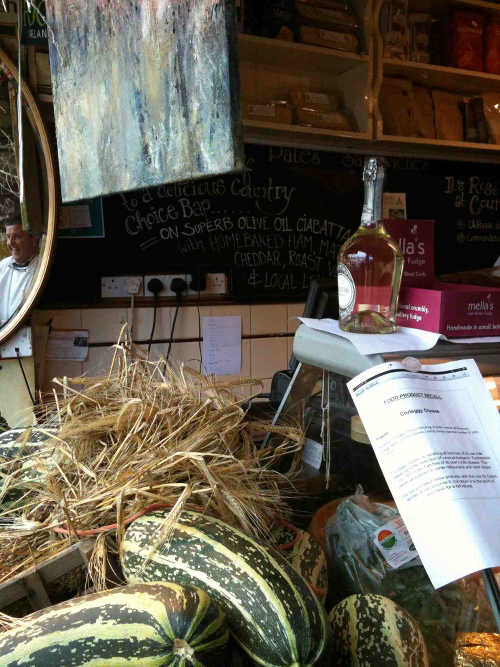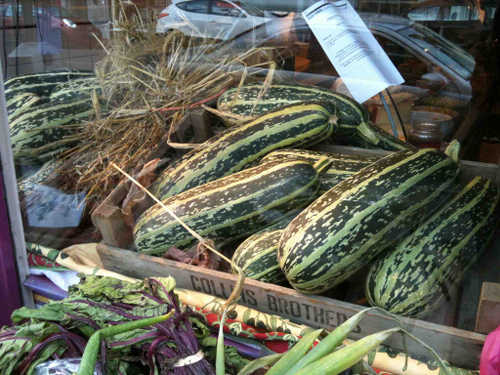Marrows - In Season
 A gorgeous display of marrows in the window of the Ward family’s superb shop and café, Country Choice, in Nenagh, Co Tipperary has reminded me that we hear plenty about other, more exotic, members of the Cucurbita (gourd) family - which includes squash and pumpkin - but very little about the whopper marrows that I remember from my childhood.
A gorgeous display of marrows in the window of the Ward family’s superb shop and café, Country Choice, in Nenagh, Co Tipperary has reminded me that we hear plenty about other, more exotic, members of the Cucurbita (gourd) family - which includes squash and pumpkin - but very little about the whopper marrows that I remember from my childhood.
In those days stuffed marrow was a regular on the family dinner table and my mother had countless tricks up her sleeve to make good use of this abundant food. Growing good marrows used to be a point of honour in the country, and they usually took pride of place on top of the compost heap where they were warm and well fed. As children, watching the plants develop from seeds to thriving plants burgeoning with big fat marrows involved regular trips to the compost heap, which was itself an education for life.
Perhaps that kind of gardening has less appeal these days, but the revival of interest in self-sufficiency - or, at least, in finding local sources for everyday foods - is strong and genuine.
And there are still plenty of marrows around, in Co Tipperary at any rate, and there are many ways of using them. The flesh is very delicate, providing a neutral background for more robustly flavoured fillings, sauces etc, in much the same way as potatoes, pasta or rice - but without the high carbohydrate content.
There are endless ways to cook marrow, your imagination is the only limitation. Aside from the many variations on baked marrow (halved, deseeded, stuffed with a tasty mixture of your choice, and baked until tender), most involve removing the (tough) outer skin and scooping out the seeds and membrane in the middle; you then have a satisfying large amount of flesh to play with.
 Try it cut into big chunks and baked around the Sunday roast, for example, or maybe think Mediterranean - ratatouille/ piperade family - and create a herby sauce or stew using marrow, tomatoes, garlic and whatever other late summer vegetables may still be to hand.
Try it cut into big chunks and baked around the Sunday roast, for example, or maybe think Mediterranean - ratatouille/ piperade family - and create a herby sauce or stew using marrow, tomatoes, garlic and whatever other late summer vegetables may still be to hand.
Mixed with other well-flavoured vegetables, it’s useful in soups and a plethora of side dishes - and surprisingly perhaps, given the high water content, it can also be fried or deep-fried successfully (treat like aubergine, ie salt well to bring out the juices, then rinse and pat dry before proceeding). Whatever you choose to do, the great strength of the marrow is the very thing that many would see as a downside; ie its neutral (some would say bland) flavour, which – like chicken - allows the cook a free hand with complementary ingredients, including a wide range of pulses, herbs and spices.
And then, of course, there are preserves A spicy chutney is a great way of producing something special for the store cupboard with this unassuming vegetable and this piquant preserve complements all kinds of cold meats, or simply fresh wholemeal bread and farmhouse cheese.
Although it wouldn't originally have included the sweet peppers, this is basically a traditional recipe and would have been familiar in many a farmhouse kitchen down through the years.
RECIPE: Marrow and Tomato Chutney
One 3 lb/1.4 Kg marrow, or equivalent
3 oz/75g salt
8 oz/225g windfalls or cooking apples
l large onion
l red pepper
l green pepper
4 oz/100g dates, stoned
6 oz/175g seedless raisins
l lb/450g red tomatoes
l pint/575 ml vinegar
½ oz/12g mustard seed
2 rounded teaspoons grated root ginger
2 flat teaspoons ground allspice
l flat teaspoon ground cinnamon
l flat teaspoon ground mace
l lb/450g Demerara sugar.
Makes about 6 lb/2.7 Kg.
Peel the marrow, remove the seeds and pith and cut the flesh into small cubes. Arrange in layers in a large bowl, with the 3 oz/75g salt scattered through them. Cover and leave in a cool place for 24 hours. Drain the marrow thoroughly in a colander, then rinse under the cold tap and drain well again.
Meanwhile, peel, core and chop the apples, discarding any bruises and make up the weight as necessary. Chop the onion quite finely. Remove stems, seeds and membranes from the peppers and chop the flesh. Peel the tomatoes and chop roughly.
Put all the ingredients except the marrow and sugar into a preserving pan or heavy-based saucepan and cook over low heat for about 1½ hours until tender.
Stir in the sugar and, when it has dissolved, stir in the marrow cubes. Simmer for an hour or so, stirring occasionally to prevent sticking, until the marrow is soft and most of the liquid has evaporated.
Pour into clean wide-necked jars.
When cold, cover with vinegar-proof lids - plastic-lined metal is alright, but be careful not to use untreated metal lids. Label and store in a cool, dark place. Although it can be used immediately, the chutney is best left for about two months before use, to let the flavours mellow and mature.





There are currently no comments
Leave a comment
Not a member? Register for your free membership now!
Or leave a comment by logging in with: